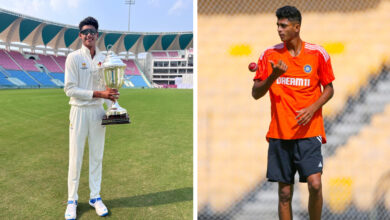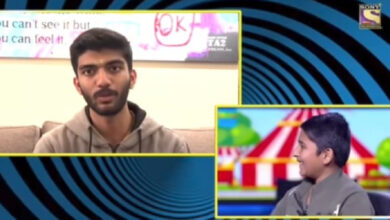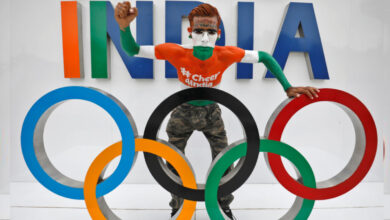Paralympic champion Pramod Bhagat turning disability into strength

Pramod Bhagat went all the way to Paris to fall in love with his weakest link. All his life, the Tokyo Paralympics gold medall shuttler in S3 category has worked every remaining muscle of his body to compensate for a disability in his left leg, brought on polio. Never had the four-time World Champion been told that his perennially-protected leg ought not to be shielded, but launched into attack while lunging.
In the first 10 minutes of his 10-day training camp in Paris at France’s badminton development centre, the European coaches had lobbed a hitherto unheard poser at him: Why was he ‘hiding’ his left leg, so to speak, when playing?
On a two-month training stint in Spain where he will proceed to play a clutch of tournaments, Bhagat is upbeat about this refreshing way of thinking that was spelt out to him when he travelled for a short camp to Paris. “I normally under-utilise my left leg, because I know it’s weak and affected. But coach Mike there (he only addressed the English coach in Paris with his first name) told me that I can and should start taking training load on the left leg. I’ve loved the idea, and his plan, and I’ll follow through on that line of thinking,” Bhagat stresses.
Coaches at the French centre encouraged Pramod Bhagat to add training load on his left leg, weakened polio when he was a child. He’s leading with left leg now. (Video: Indian Express) pic.twitter.com/NTz3t2Cp0C
— Express Sports (@IExpressSports) February 22, 2022
The technical advice he received, Bhagat reckons, is an extension of the way Europe culturally views disability. “They don’t look at you with pity and sympathy. They said I’m an elite athlete and I have to turn every muscle into strength, maybe the weaker one will require more training. They don’t see disability as demotivating,” he recalls. “When I started, I thought they’ll use the usual shadow and multi-shuttle feed. But after just 10 minutes, they had me recorded, analysed on video, and we spent the next hour and a half on planning on how to achieve perfection in my weak leg,” he adds.
The Tokyo champion needed a reboot of his game, after a string of felicitations left him restless about sitting on his laurels. “I knew I had to get back on court and improve my game after I lost early in a tournament in Uganda.”
What followed was a training plan in Spain to get back into the groove. “I’ve trained in India for 20 years, with great benefits and achieved the milestone of winning the Paralympics. But I need extra tech inputs. Everyone is working hard, but if I just go with the flow, it won’t be enough. I have to become better,” he says.
Paralympic S3 champ Pramod Bhagat is looking to up-skill and increase his speed while training in Spain and France ahead of upcoming tournaments. (Express Photo)
European badminton – especially Spain and France, the next Olympics hosts – have fast-tracked their development programmes and are relying heavily on sports science to catch up with Asian dominance in badminton. “They might not be as good as Asians on skill,” says the 33-year-old who honed his hand skills at an Indonesian camp in 2016, “but they are working at another level on speed to reach under the shuttle early. They tend to be tall, but are adding power on the hitting shoulder with biomechanics and all drills are focused on speed.”
Eye-opener
For someone who grew up nurturing reverse returns and dribbles, maxing out the full strength on the smash and then tempering it to half power for variations has been a new priority, if not entirely a revelation. “In India, we do this in parts. But here, I trained with their able-bodied 15-19-year olds. And their speedwork is something else,” he stresses. Their idea of taking a breather was playing at the BlazePod, a light-based reflex training system where one taps on audio clues of different colours.
While the Danes and English have influenced how rest of Europe trains, France taking up badminton after winning hosting rights, has gone full throttle with recovery equipment and high-altitude chambers for juniors. “In India, I’d have to go to a hill station. But here though it was only a few hours of access to their hill training, I was impressed with what their athletes are doing,” he adds. “What I also learnt was to put more power on the third smash than the first and second.”
The dynamic nature of his training in Paris where coaches didn’t just hand out a schedule of drills, but paused after knocking every few minutes to completely analyse the game and prop up weak strokes (parallel game in his case), has left Bhagat regaining his own tinkering, tweaking spirit where he constantly fiddles with technique. His rallying style was also revised – less of the box game, more of the European two-line playing juggles. “Just hard work doesn’t matter if I have to defend my title. I’ll have to get double better,” he says, adding the world better watch out at both Games as Carolina Marin isn’t a rare phenomenon, and a French surge is imminent. “Who made the Syed Modi men’s singles finals?” he asks, referring to a pair of Frenchmen.
Paralympic S3 champ Pramod Bhagat (Second from left) is looking to up-skill and increase his speed while training in Spain and France ahead of upcoming tournaments. (Express Photo)
Shuttle-throwing robot machines are all over French elite academies, spitting out toss, drop, smashed birds. And with 4-5 coaches for 14-15 players, there’s more personalised attention. “I’ll return and train for longer,” he says, now back in Spain.
Bhagat was most impressed parking spots earmarked for the disabled, and a whole range of accessibility tools available to him. “Since we are staying a little far off, we hired a specially-designed rental car. Took some time to get used to it, but now I’m scared I’ll struggle to drive back in India,” he laughs.
Food was another tricky issue for the vegetarian, though he warmed up to the idea of French and Spanish athletes taking the weekends completely off and showing him around. “We are not used to switching off in India,” he chuckles.
The language posed a challenge initially, though he makes light of communication which has flowed ever since. “Google baba zindabaad! Meri bhi English mein kamzori hai, aur French players ki bhi. Aur dushman ka dushman dost hota hai (I am weak in English, and so are the French players. Two negatives combined to make a positive). I learnt basic French greetings and even spoke to the English coach in French,” he laughs. “We use our tongue more to speak. They have a throaty way of speaking. Bas woh mujhe aayaa nahi (I just couldn’t learn that),” he says. “In the end, we could understand each other – speed and fast fast we all understood,” he ends.







